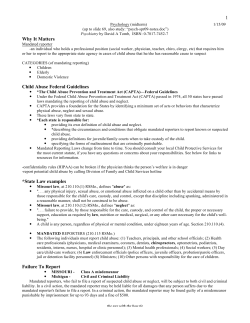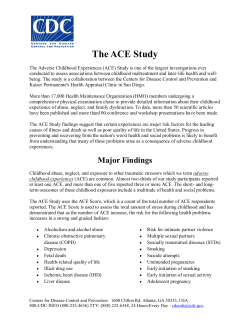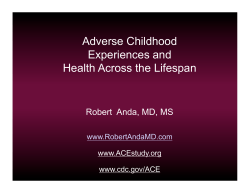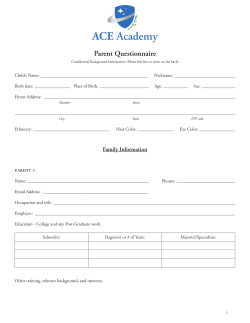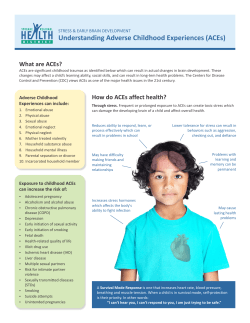
ACE issue brief 4: mental illness & substance abuse The Innovation Center
ACE issue brief 4: mental illness & substance abuse Findings of the Adverse Childhood Experience (ACE) Study Oklahoma KIDS COUNT Factbook, 2006–2007 Issue Brief 4 of 5 The Innovation Center the ACE study findings The Adverse Childhood Experience (ACE) Study is a large-scale, ongoing evaluation The results were startling. Adverse of the link between negative childhood experiences and the origins of risk behaviors childhood experiences are vastly more that evolve into the leading causes of disease and disability in adulthood. The study is a common than generally recognized. Almost collaborative effort between the Centers for Disease Control and Prevention and Kaiser three-quarters of the participants reported Permanente’s Department of Preventive Medicine. having experienced at least one ACE. More The study conducted detailed biomedical and psychological evaluations of over 17,000 than one in five reported three or more, middle-aged, middle-class Kaiser patients. The study was designed to simultaneously assess indicating that risk factors rarely occur in childhood exposure to multiple types of abuse, neglect, parental substance abuse, domestic isolation. For example, many cases of child violence, and other types of serious household dysfunction. A scoring system was used to abuse also involve drug abuse, domestic analyze the findings: a person exposed to none of the 10 factors had an ACE score of 0; a violence and divorce. The study showed a person exposed to any four factors had an ACE score of 4, and so on. The scores were then powerful and compelling correlation between compared with the health status of these individuals. harmful experiences in childhood and adult health status decades later. explaining the connection The ACE Study provides insight into how their ACE score, the greater the likelihood our experiences as children evolve into risky of adopting multiple risk behaviors, such as behaviors, which, in turn, evolve into disease alcohol or drug abuse, smoking, overeating and death. Child abuse and household and promiscuity. trauma leave a child vulnerable, actually disrupting the normal development of the This series of issue briefs will explore the implications of the ACE Study in Oklahoma, brain. The study suggests that children and provide a basis for discussion among and adolescents adopt risky behaviors as a parents and other child advocates, health and means of coping or covering their pain. The social service professionals, policy makers and more trauma they experience, i.e. the higher community leaders. 33% 1 26% 2 16% 3 10% 4 or more (up to 10) 12.5% Compared to persons with an ACE score of 0, those with an ACE score of 4 or more were twice as likely to be smokers, 12 times more likely to have attempted suicide, 7 times more likely to be alcoholic, and 10 times more likely to have injected street drugs. death adoption of health-risk behaviors scientific gaps early death diabetes whole life perspective disease, disability and social problems adverse childhood experiences 0 ACE Pyramid: Real Life Scenario early death social, emotional and cognitive impairment total overeating conception conception whole life perspective death ACE Pyramid: Conceptual Framework number of adverse childhood experiences (ACE score) sexual abuse depression major findings of the ACE study Many studies have examined the impact of a single type of maltreatment on children. Yet the ACE Study found that co-occurrence of multiple forms of childhood abuse and household dysfunction is common, and their effects are cumulative. In Oklahoma, there is no data to track co-occurrence of abuse or dysfunction on individual children and families, i.e. whether a single child is victimized in multiple ways. Oklahoma KIDS COUNT has gathered county-by-county data to determine which counties report high incidents of adverse childhood experiences. mental illness & substance abuse: state level findings Mental and addictive disorders impose a has one of the nation’s highest rates of of treatment. Nearly 38,000 Oklahoma greater burden of disability on Oklahoma mental illness, estimated to be at 11% of women are in need of substance abuse citizens than cardiovascular disease or the adult population, or almost 300,000 treatment, and almost 3,000 of those are cancer. This was the surprising finding people. The national average is 9.2%. pregnant. These numbers do not include of the Oklahoma State Board of Health Addictive disorders, including alcohol, figures for tobacco addiction. and the Board of Mental Health and tobacco and other drugs, are the number Substance Abuse Services in a 2003 one public health problem in Oklahoma remains one of the single most important joint report. Though the leading cause and nationally. It is estimated that preventable causes of poor outcomes for of disability worldwide is infectious nearly 140,000 Oklahoma adults need both mother and baby. Yet nearly one in disease (22.9%), the leading cause in treatment for alcohol addiction, and an five pregnant Oklahomans smoke during developed nations is neuro-psychiatric additional 21,000 people need treatment their pregnancies. Moreover, postpartum disorders (25.5%). for other types of drug addiction. recidivism is high: almost 59% of women Especially worrisome are the numbers of who quit during pregnancy resumed pregnant and parenting mothers in need smoking after delivery. These reports make Oklahoma’s predicament especially dire. Oklahoma Tobacco use during pregnancy Household or Family Dysfunction Household Substance Abuse Lived with anyone who was a problem drinker or alcoholic and/or lived with anyone who used street drugs. Household Mental Illness A household member was depressed or mentally ill and/or a member attempted suicide. implications of ACE study Household mental illness and substance plays out in Oklahoma, where research Oklahoma is staggering. The Governor’s abuse significantly create the risk of an found that drug and alcohol addiction and Attorney General’s Blue Ribbon Task unpredictable home life, and are linked to contributes to: Force conservatively placed the costs at higher rates of domestic violence, divorce, 85% of all homicides more than $3.2 billion annually in direct unemployment, and involvement in the 80% of all incarcerations expenditures. The majority of these costs criminal justice system. The children in 75% of all divorces are related to safety and security issues, as these households have a higher prevalence 65% of all child abuse cases well as the contribution of substance abuse of depression, anxiety, eating disorders and 55% of all domestic assaults to domestic violence, sexual assault and suicide attempts than their peers. the resulting child abuse and neglect. This The financial costs of dealing with underscores the findings of the ACE Study of an alcoholic parent doubled the risk of mental illness and diseases caused by regarding the intermingled and cumulative every other ACE category. This certainly tobacco, alcohol and other drug abuse in effect of family dysfunction. The ACE Study found that the presence policy opportunities The ACE Study confirmed that exposure to parental alcohol -practitioners treating abused and neglected children abuse is highly associated with the occurrence of additional must ensure that the children’s parents are screened for adverse childhood experiences, and the increased likelihood substance abuse that children of alcoholics will themselves become alcoholics. The ACE researchers recommend the following to interrupt the intergenerational cycle of adverse childhood experiences, and reduce the negative health consequences in adolescents and adults: Improve the coordination of adult and pediatric health care with related mental health and substance abuse services -expand the information gathered on medical histories to include exposure to adverse childhood experiences -inform physicians about available treatment services for mental health and substance abuse, and domestic violence services Develop the means to co-manage care Other Oklahoma organizations have made additional recommendations. As a result of their 2005 Town Hall Meeting on Drugs, The Oklahoma Academy recommended the following: Allocate state resources for mental health and substance abuse treatment -shift resources from high cost (low effectiveness) incarceration to lower cost (higher effectiveness) prevention and treatment programs -expand the use of drug and mental health courts, and other community-based services -provide drug treatment programs during incarceration and probation -practitioners who treat individuals abusing substances should -provide greater educational opportunities (high school be aware that these individuals’ families need assessment GED, college credits, career tech) to those exiting prison for the increased probability that child abuse and neglect, to reduce recidivism domestic violence, and other forms of household dysfunction -provide post-incarceration reintegration assistance are co-occurring Beaver Harper Woods Alfalfa Woodward best region better region bad region worse region worst region Custer Canadian Oklahoma Beckham state rate: 11.02% of adults county avg: 10.79% adults Greer Harmon Creek Lincoln Cleveland Caddo Washita Grady McClain Kiowa Wagoner Cherokee Okmulgee Muskogee Okfuskee McIntosh Adair Sequoyah Haskell Hughes LeFlore Pittsburg Latimer Coal Stephens Tillman Tulsa Delaware Pontotoc Garvin Comanche Jackson Nowata Craig Ottawa Rogers Mayes Pawnee Blaine Kingfisher Logan below avg region Roger Mills Noble Payne Dewey above avg region Osage Garfield Major Ellis Kay Grant Seminole Texas Pottawatomie Cimarron Washington percent of adults experiencing severe psychological distress (2002–2004) Murray Pushmataha Atoka Johnston Cotton Carter Jefferson Marshall Love McCurtain Choctaw Bryan Beaver Harper Woods Alfalfa Woodward best region better region worst region state rate: 5.14% of adults county avg: 4.78% adults Roger Mills Creek Lincoln Custer Canadian Oklahoma Beckham Greer Jackson Cleveland Caddo Washita Grady McClain Kiowa Wagoner Cherokee Okmulgee Muskogee Okfuskee McIntosh Adair Sequoyah Haskell Hughes LeFlore Pittsburg Latimer Coal Stephens Tillman Tulsa Delaware Pontotoc Garvin Comanche Nowata Craig Ottawa Rogers Mayes Pawnee Blaine Kingfisher Logan below avg region Harmon worse region Noble Payne Dewey above avg region Osage Garfield Major Ellis Kay Grant Seminole Texas Pottawatomie Cimarron Washington percent of adults dependent on alcohol or illicit drugs (2002–2004) Murray Pushmataha Johnston Cotton Jefferson Carter Love Atoka Marshall Bryan McCurtain Choctaw mental illness & substance abuse Household or Family Dysfunction Mental Illness/Substance Abuse ACES three year 2002-2004 substance abuse rank Substance Abusing Household Member three year 2002-2004 substance abuse rate three year 2002-2004 psycholog. distress rank Mentally Ill Household Member three year 2002-2004 psycholog. distress rate three year 2002-2004 substance abuse rank county name Substance Abusing Household Member three year 2002-2004 substance abuse rate three year 2002-2004 psycholog. distress rank Mentally Ill Household Member three year 2002-2004 psycholog. distress rate county name Household or Family Dysfunction Mental Illness/Substance Abuse ACES STATE TOTALS 11.02% 5.14% Latimer County 10.89% tie for 43 4.57% tie for 11 Adair County 11.91% 4.23% tie for 1 Le Flore County 10.89% tie for 43 4.57% tie for 11 tie for 67 Alfalfa County 10.38% tie for 1 5.00% tie for 31 Lincoln County 11.91% tie for 67 4.23% tie for 1 Atoka County 10.89% tie for 43 4.57% tie for 11 Logan County 10.38% tie for 1 5.00% tie for 31 Beaver County 10.38% tie for 1 5.00% tie for 31 Love County 10.89% tie for 43 4.57% tie for 11 Beckham County 10.38% tie for 1 5.00% tie for 31 McClain County 11.30% tie for 63 5.25% tie for 72 tie for 11 Blaine County 10.38% tie for 1 5.00% tie for 31 McCurtain County 10.89% tie for 43 4.57% Bryan County 10.89% tie for 43 4.57% tie for 11 McIntosh County 11.91% tie for 67 4.23% tie for 1 Caddo County 10.38% tie for 1 5.00% tie for 31 Major County 10.38% tie for 1 5.00% tie for 31 Canadian County 11.30% tie for 63 5.25% tie for 72 Marshall County 10.89% tie for 43 4.57% tie for 11 Carter County 10.89% tie for 43 4.57% tie for 11 Mayes County 10.42% tie for 30 4.72% tie for 31 Cherokee County 11.91% tie for 67 4.23% tie for 1 Murray County 10.89% tie for 43 4.57% tie for 11 Choctaw County 10.89% tie for 43 4.57% tie for 11 Muskogee County 11.91% tie for 67 4.23% tie for 1 Cimarron County 10.38% tie for 1 5.00% tie for 31 Noble County 10.42% tie for 30 4.72% tie for 31 tie for 31 Cleveland County 11.30% tie for 63 5.25% tie for 72 Nowata County 10.42% tie for 30 4.72% Coal County 10.89% tie for 43 4.57% tie for 11 Okfuskee County 11.91% tie for 67 4.23% tie for 1 Comanche County 10.38% tie for 1 5.00% tie for 31 Oklahoma County 10.43% 42 5.86% tie for 76 Cotton County 10.38% tie for 1 5.00% tie for 31 Okmulgee County 11.91% tie for 67 4.23% tie for 1 Craig County 10.42% tie for 30 4.72% tie for 31 Osage County 10.42% tie for 30 4.72% tie for 31 Creek County 11.91% tie for 67 4.23% tie for 1 Ottawa County 10.42% tie for 30 4.72% tie for 31 Custer County 10.38% tie for 1 5.00% tie for 31 Pawnee County 10.42% tie for 30 4.72% tie for 31 Delaware County 10.42% tie for 30 4.72% tie for 31 Payne County 10.42% tie for 30 4.72% tie for 31 Dewey County 10.38% tie for 1 5.00% tie for 31 Pittsburg County 10.89% tie for 43 4.57% tie for 11 Ellis County 10.38% tie for 1 5.00% tie for 31 Pontotoc County 10.89% tie for 43 4.57% tie for 11 Garfield County 10.38% tie for 1 5.00% tie for 31 Pottawatomie County 10.89% tie for 43 4.57% tie for 11 Garvin County 10.89% tie for 43 4.57% tie for 11 Pushmataha County 10.89% tie for 43 4.57% tie for 11 Grady County 11.30% tie for 63 5.25% tie for 72 Roger Mills County 10.38% tie for 1 5.00% tie for 31 Grant County 10.38% tie for 1 5.00% tie for 31 Rogers County 10.42% tie for 30 4.72% tie for 31 Greer County 10.38% tie for 1 5.00% tie for 31 Seminole County 10.89% tie for 43 4.57% tie for 11 Harmon County 10.38% tie for 1 5.00% tie for 31 Sequoyah County 11.91% tie for 67 4.23% tie for 1 Harper County 10.38% tie for 1 5.00% tie for 31 Stephens County 10.38% tie for 1 5.00% tie for 31 Haskell County 10.89% tie for 43 4.57% tie for 11 Texas County 10.38% tie for 1 5.00% tie for 31 Hughes County 10.89% tie for 43 4.57% tie for 11 Tillman County 10.38% tie for 1 5.00% tie for 31 Jackson County 10.38% tie for 1 5.00% tie for 31 Tulsa County 12.08% 77 5.86% tie for 76 Jefferson County 10.38% tie for 1 5.00% tie for 31 Wagoner County 11.91% tie for 67 4.23% tie for 1 Johnston County 10.89% tie for 43 4.57% tie for 11 Washington County 10.42% tie for 30 4.72% tie for 31 Kay County 10.42% tie for 30 4.72% tie for 31 Washita County 10.38% tie for 1 5.00% tie for 31 Kingfisher County 10.38% tie for 1 5.00% tie for 31 Woods County 10.38% tie for 1 5.00% tie for 31 Kiowa County 10.38% tie for 1 5.00% tie for 31 Woodward County 10.38% tie for 1 5.00% tie for 31 This issue brief is the fourth in a series describing the impact of adverse childhood experiences on adult health status. This brief is made possible through Project ACT (All Children can Thrive), a project of the Oklahoma Institute for Child Advocacy in partnership with Oklahoma KIDS COUNT, the Oklahoma Department of Mental Health and Substance Abuse Services, and the Innovation Center. Publication of this brief was funded in part by a Transformation State Incentive Grant (SM-05-009) awarded to Oklahoma by the Substance Abuse and Mental Health Services Administration. All five issue briefs and the Oklahoma KIDS COUNT Factbook will be available online at www.oica.org in January of 2007. 420 NW 13th Street, Suite 101, Oklahoma City, Oklahoma 73103 phone: 405.236.KIDS (5437) fax: 405.236.KIDX (5439) www.oica.org
© Copyright 2025
